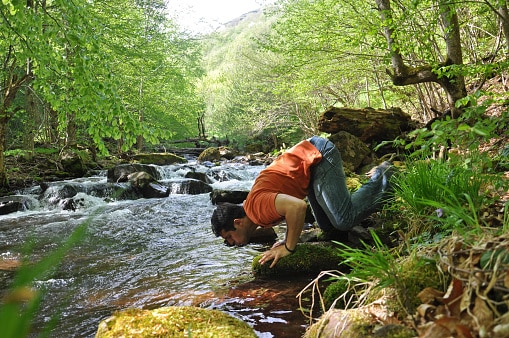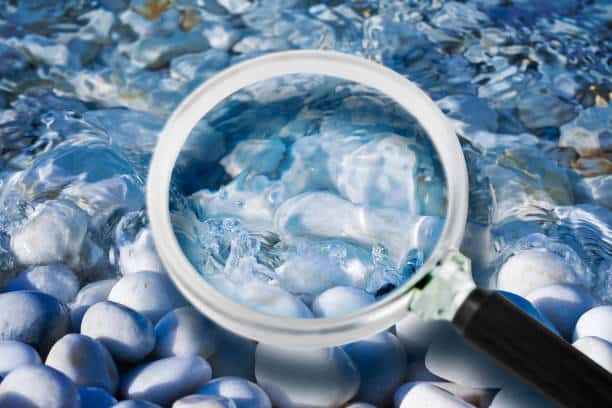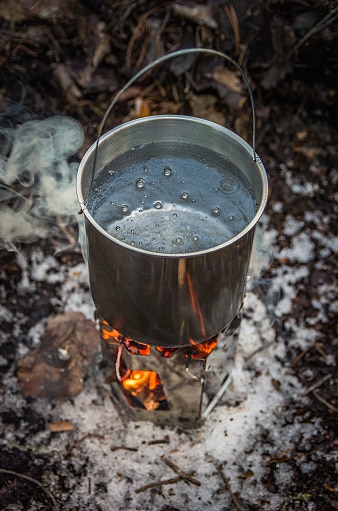As a seasoned outdoor enthusiast and survival expert, I’ve had my fair share of close encounters with wilderness risks. One vital lesson that stood out is the importance of being able to identify drinkable water. When you’re out and about, trekking through rough terrains or setting up camp in the wild, the knowledge of how to determine potable water can indeed be a lifesaver.
We all know water is a basic necessity. However, carrying a significant amount with you can become a hefty burden, especially when each quart weighs about 2 pounds. So, wouldn’t it be convenient if we could find a reliable source of drinkable water in our environment? As much as it sounds like a great idea, knowing if the water is safe to drink is the tricky part.

Here’s a comprehensive guide to help you determine drinkable water sources, especially for hikers, campers, day-trippers, and indeed, all outdoor enthusiasts.
Recognizing Contaminated Water
Observing the surrounding area is the first step in identifying if the water source might be contaminated. Keep an eye out for decomposing animals as they release germs into the water. Also, small animals defecating on rocks might introduce unseen contaminants into the water that washes over them into the stream. The water might look pristine, but it could be a breeding ground for germs or parasites.
Turbidity or cloudiness in the water could signal contamination. Although outdoor water often becomes muddy after a storm and later clears up, it’s better to avoid water that remains cloudy. Use your senses to gauge if the water has a foul or chemical smell. Observe if there are insects or birds around the water source, or signs of surface algae, slick, oily layer, or foam floating on the surface.
Consider investing in a water testing kit for outdoor adventures. These kits typically include small strips of paper that you can moisten and compare with a color chart to identify common bacteria like salmonella.

Locating the Cleanest Possible Source
In nature, you’ll find groundwater and running water sources most often in valleys, ravines, and other low spots, courtesy of gravity. Prioritize running sources over stagnant ones, as flowing water tends to be cleaner.
Before consuming water from any source, scrutinize the surrounding area for potential pollutants. Decaying animals and animal feces could contaminate water sources with pathogens like cryptosporidium. Avoid water sources close to urban areas or underneath highways, as these are likely to contain toxins. The same goes for water flowing through industrial complexes, which could carry harmful compounds detrimental to your health.

Treating Your Water Source
Boiling
Boiling water is one of the most reliable ways to purify it. If you have a metal container or a large shell, you can boil small amounts of water. Glass containers can also serve the purpose, and so can plastic bottles if filled with water and carefully heated on coals.
Portable Filters and Purifiers
The market offers a plethora of portable water filters and purifiers. They all function similarly, removing harmful microorganisms and serving as water filters. Some filters use gravity, while others use hand pumps or are battery-powered. Some purifiers are integrated into the center of a water bottle. Note that purifiers use chemical agents in addition to the standard filtering system.
Using the Sun’s Power
Also known as solar water disinfection, this method uses UV light from the sun to treat water. For this, you need a clear plastic or glass bottle, and the water should be clear and free from debris. Fill the bottle with water and leave it in full sunlight for at least one day. Remember, this method is only effective for volumes of up to 2 quarts.
Water Purification Tablets
Having water purification tablets in your backpack can be handy. After removing large debris from the water, use the tablets as per the instructions on the packet. Purification tablets typically take around 30 minutes to work effectively.
Filtering
You can use a sock or a piece of clothing to filter out large particles, but this doesn’t remove germs. Filling your sock with sand or grass and running water through it might improve the water quality slightly.
Collecting Rainwater
Rainwater is generally safe unless you are in a city or industrial area where it could get contaminated. You can collect it in a container or by tying a waterproof cover like a tarp to trees and funneling the rainfall into your water container.
Conclusion
If you’re prepared and have the means to make fire, your best bet in a survival situation is finding the cleanest possible water source, boiling it, and allowing it to cool. But if you find yourself in the wild without the luxury of preparation, you can resort to filtering large debris from the water, using solar disinfection, or collecting rainfall and plant water.
Remember, with the right knowledge and tools, securing a safe water source the outdoors becomes significantly more manageable. It’s all about preparation and understanding how to leverage what nature provides you. Always stay alert and cautious when identifying drinkable water in the wild; your survival may depend on it.

Jay
Jay is a health and wellness enthusiast with expertise in water quality and nutrition. As a knowledgeable advocate for holistic well-being, Jay successfully manages Type 2 Diabetes through informed lifestyle choices. Committed to sharing reliable and authoritative insights, Jay combines firsthand experience with a passion for enhancing health."
